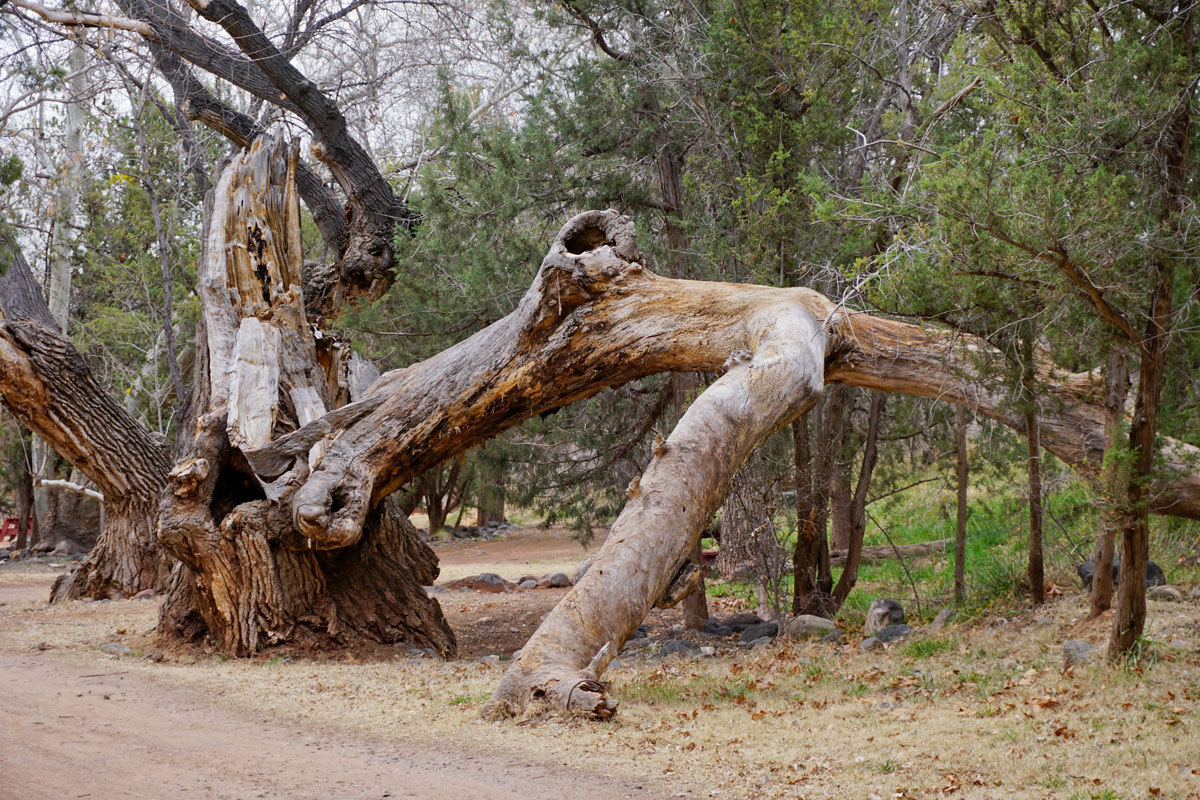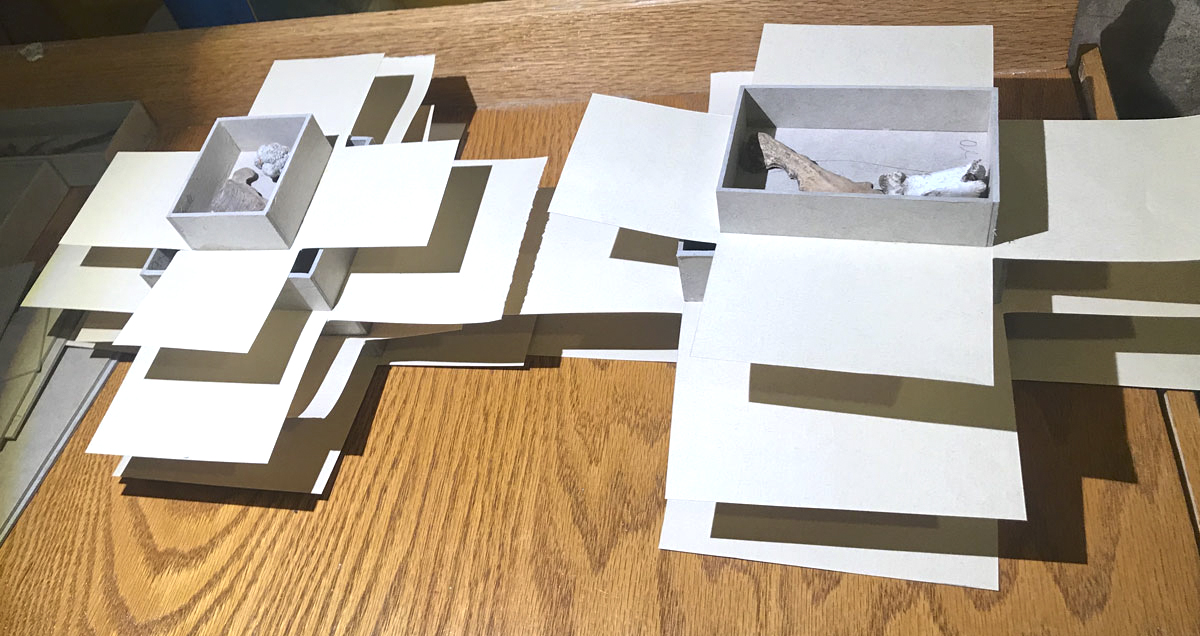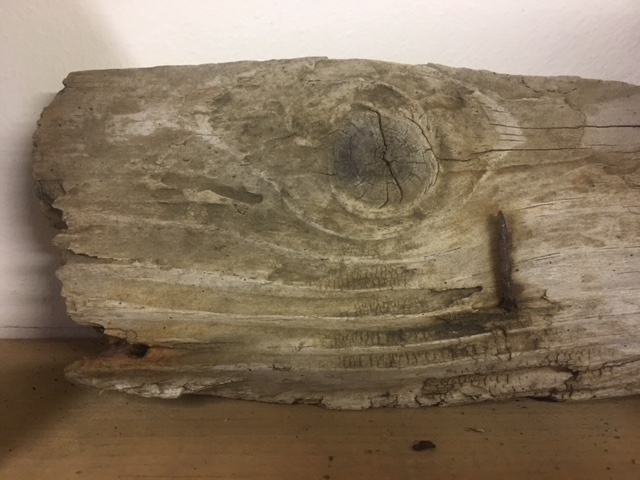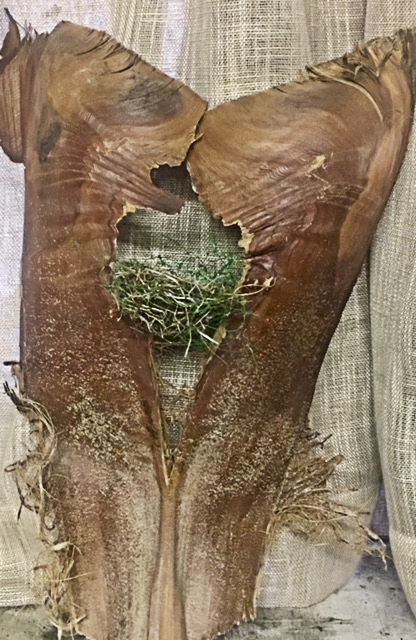Back on the road and intentionally trying to write as fast as I can. It’s challenging to get back into my work after such an extended holiday. I’ve heartily enjoyed the continuous presence of family and friends back home in Canada since the beginning of August. Now we are going South to warm up. Furthermore, it's time to get back into creating artists’ books. As I travel, the one thing that keeps catching my eyes are trees with their texture and shape.
© 2017 Louise Levergneux, Palm trees
© 2018 Louise Levergneux, Sedona, Arizona. trees give me hope and comfort
During studio visits, I connected with two artists who have in common an affinity for using driftwood, roots, and other natural elements in their art-work.
For my first blog post after a lengthy break, I bring the work of Marnie Powers-Torrey from Salt Lake City and Judith Serling-Sturm from Cincinnati.
Marnie’s work in progress—a series of boxes—its working title Archive of Now is without a declared finish date.
Marnie talks of Archive of Now:
© 2018 Marnie Powers-Torrey, Archive of Now
Maybe, I’ll consider it done when I complete a concurrent project Roadside Attractions. The paper wrappers for the boxes are printed as palimpsests of the process of printing Roadside Attractions. The plates are relief-printed collagraphs {roadside found objects mounted type high for letterpress}. Simultaneously printing projects from the same matrixes is a matter of efficiency—a necessity in our culture {the digital age} when my research relies on obsolete {slow} processes.
The roadside objects were sought like shells by a beachcomber during walks of all sorts—meditative, hurried, purposeful, lackluster—all otherwise uneventful. Initially, I had no intended plan for this rubbish. I was compelled to pick up the pieces and save them like prizes. These found pieces of the industrialized puzzle were mysteriously captivating to me, not being particularly mechanically minded. I had no recollection of many of these scraps of things—what their initial purpose was. Others, I recognized after considering for a time, and some immediately know. All were realizations of human being’s incredible and lasting ingenuity.
© 2018 Marnie Powers-Torrey, Archive of Now
© 2018 Marnie Powers-Torrey, Archive of Now
At the same time {for the past few years and now}, I began collecting sage root balls after the county cleared a new cross-country ski track and hiking trails in the open space near my home. I am enthralled with the new trails and walk them nearly every day. Still disturbed by the disruption, the annihilation of this slow-growing and remarkably hearty desert dweller. Sage is long-living—an icon of wisdom and progenitor of healing. Sagebrush’s dry wit is also a fuel source for wildfires. These root junctures are thus both castaways and wellsprings, harbingers and scepters.
© 2018 Marnie Powers-Torrey, Archive of Now
I’ve always collected things since I was very young. First rocks and then pottery shards. Also, erasers and soaps. The calling to gather, to preserve, and to keep has stayed with me. The driftwood, bones, rocks, and other organic souvenirs are memorialized and archived in these boxes. Presenting the found natural objects in this manner allows us to refocus on the micro, to recontextualize the beauty of these nothings that would otherwise continue to naturally decay in the natural environment. The still beauty of nature’s readymades is engulfed by the bits of manmade machinery meant for motion. Each naturally occurring object gains an aura, surrounded by the impressions made from objects shaped from raw materials by man. Both nature’s and human’s byproducts are talismans to hold tightly into the uncertain future.
© 2018 Marnie Powers-Torrey, Archive of Now
Some boxes hold typed text while others are purely visual. The text is serendipitous meditations—translations that come to mind as I handle and contain each object. I am reticent to include text in all boxes as I’d like the viewer to discover personals effigies. I hope the text that I do include provides permission to follow our visual intuition when looking and excavating meaning. I invite the viewer to appreciate the beauty of these objects for what they are while also imagining what their shapes and presence suggest.
© 2018 Louise Levergneux, found objects in Judith Serling-Sturm’s studio
Judith explains some of the pieces of driftwood and bark that she has collected and how they will be integrated in artists’ books in the future.
Frequently, I am drawn to a piece by its texture; the vertical striations of a honeysuckle branch, the knobbed shingles of persimmon bark, the smoothness of a knotty branch lapped by years of slapping waves. Other time the shape invites me.
© 2018 Judith Serling-Sturm, I discovered this unique piece on a hike shortly after reading Walt Whitman—for me it evokes the free celebration of self, body, and soul—and one of these days, when I have no pressing duties, I will incorporate this piece into a fan book...
© 2018 Judith Serling-Sturm, I uncovered this piece of wood by a construction site... it just looked up at me, the bent rusted nail a tear seeping from the knot of an eye—and there is so much to cry about these days... it will undoubtedly become a cover for an artist book.
© 2018 Judith Serling-Sturm, this palm bark, another form that speaks to me with its female form... one of my many long-term projects is one about ‘Home’ after moving so many times. For several years I have interviewed people to learn what they mean when they talk about ‘home.’ This unfinished piece refers to my immigrant grandparents and my grandfather’s assertion that, as Edward Sharpe says, Home is wherever I’m with her.
© 2018 Judith Serling-Sturm, this is an artist book with a nest and a condom wrapper woven into it! How can it not be an artist book about the naturalness of using contraception?
© 2018 Judith Serling-Sturm, when I found this stick, I immediately began thinking about how all creatures leave their mark in the world, how we create and at the same time possibly destroy as we strive for a meaningful life.
Time and again a natural element will prompt me to think things in an innovative way, as in this last case. It may never actually be incorporated into the actual artist book about that issue.
And sometimes a piece of wood is collected just because it's beautiful. And that is equally valuable.
I have been attracted to trees especially in the hills of Texas but nothing has come to mind for a future project yet! What about you, have trees, driftwood, or other found objects conveyed ideas for an artists’ book, art piece, or series? If so, what have you produced with them?













